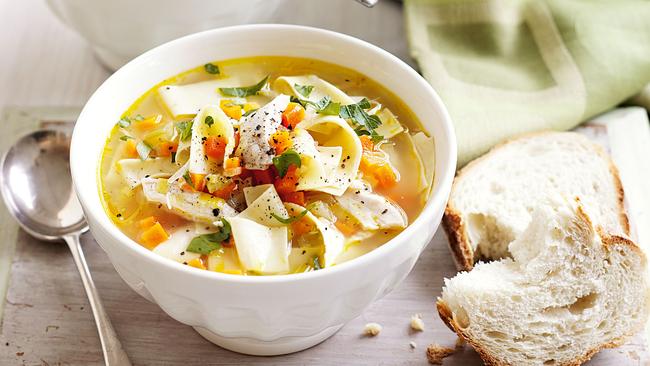Taste: Let’s make it clear
CHICKEN soup in all its variations is widely used, not just at lunch, but for its medicinal properties.

Food and Wine
Don't miss out on the headlines from Food and Wine. Followed categories will be added to My News.
HER yaya might prepare avgolemono, a lemon chicken soup, for a poorly Greek girl.
Asians feeling not quite themselves might be administered chicken pho or congee, a more palatable version of the Western gruel of old.
Most famous of all is “Jewish penicillin”, the chicken soup that Jews were being advised
to “take” for infections of the respiratory tract by physician Maimonides back in the
12th century.
Margaret Fulton prescribes chicken soup over casseroles for both the ill and the grieving.
Kate Gibbs reports her grandmother’s thoughts on the matter in Margaret and Me (Murdoch Books).
“Colourful foods and spicy foods are stimulating and it’s not a time you want to be stimulated,” Fulton says.
“That’s why the chicken soup is my favourite, because again, it’s pale and you don’t do the things like brown the meat, like you would for a casserole, so it hasn’t got that savoury smell. It has got a lovely reassuring smell.”
That said, many find a chilli-laden laksa or tom yum soup just the thing for a cold, if not a tummy upset.
Modern research finds some backing for Maimonides and all those Jewish mothers. Chicken soup was found to inhibit the migration of white blood cells (thought to contribute to cold symptoms) to the chest.
It also found chicken soup helped get the mucus moving in a blocked nose.
As with so many other instances of food as therapy, the scientists were unable to isolate a biologically active compound that they could press into a pill – you have to drink the soup.
Chicken soup is most often cited as treatment for a cold but it also is effective treatment for other miserable-making ailments and for strengthening convalescents.
And it can provide a psychological boost, especially if someone else has gone to the trouble of making it for you.
The soup renowned as Jewish penicillin is not thick with barley, rounds of leeks, chopped carrots, nor even chunks of chicken. “Hearty” does not apply to this medicinal elixir. This chicken soup is clear and golden, easily sipped from a cup without need of a spoon.
In The Book of Jewish Food (Penguin), Claudia Roden says the golden colour used to be contributed to the soup (which is a favourite at weddings and holidays as well as the sickbed) by globules of fat.
Nowadays, chickens are not so fat and fat is often taken off for health reasons, so the golden colour comes from a pinch of saffron or turmeric.
I sometimes see Nichols Poultry broilers for sale, but you could not rely on being able to buy one right at the time you need it.
Given that we most often will be making our chicken soup from young chooks, New Zealand food writer Lois Daish advises against adding a great many vegetables and herbs to the stock if what is wanted is a soup that is the essence of chicken.
For a whole chicken she uses only one very small onion, one very small sliced carrot and half a stick of celery. (There is also a small slice of fresh ginger, a sprig of thyme, two parsley stems, several peppercorns and a teaspoon of salt, all covered in cold water.)
The soup should be gently brought to the boil, and the scum skimmed off, then gently simmered for three hours – boiling the soup rapidly causes it to become cloudy.
When it is cooked, the soup is drained, and can be left in the fridge overnight to make the fat easy to remove, which also improves the clarity of the soup.
To eat, add just a pinch of turmeric, chopped parsley and salt to taste. Or soup extras, such as noodles, pancake strips or parsley dumplings, can be added.
My ruminations on food for the ailing were prompted when a friend seriously ill in hospital was allowed nil by mouth for the best part of a week. Her first “real” lunch was a vegetable broth – a grandiose name for a stock cube in boiling water.
Whatever its nutritional properties, it did not fit the recommendations in cooking-for-invalids sections in old recipe books that “light and nourishing” diets for invalids should be tempting.


